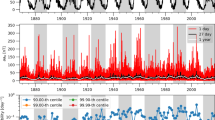Abstract
Based on vector magnetic data from the CHAMP German satellite, average daily spherical harmonic models of the main geomagnetic field to n = m = 10 have been constructed for the period from May 2001 to the end of 2009 at an interval of 4 days. The obtained 16 models, which were averaged over half a year, have been used to calculate the coordinates of the north and south magnetic poles (the points where magnetic field lines are vertical). The changes in these coordinates during these eight and a half years have been traced. Both poles continue moving northward and westward. The north magnetic pole has traveled 400 km during this period. The velocity of its motion has increased up to the year 2003, reaching 62.5 km yr−1, and then started decreasing and reached 45 km yr−1 by the end of 2009. In addition, the direction of motion changed from north-northwestward to northwestward; i.e., the pole started turning slightly towards Canada. The south magnetic pole moved slower by an order of magnitude and has traveled 42 km during this period. The coordinates of the geomagnetic (dipole) poles and the eccentric dipole parameters have also been calculated. The dynamics of these poles has been traced.
Similar content being viewed by others
References
Aubert, J., Aurnou, J., and Wicht, J., The Magnetic Structure of Convection-Driven Numerical Dynamos, Geophys. J. Int., 2008, vol. 172, pp. 945–956; doi: 10,1111/j.1365-246X.2007.03693.x.
Ben’kova, N.P., Vinnikova, T.L., and Tyurmina, L.O., Geomagnetic Eccentric Dipole, Geomagn. Aeron., 1964, vol. 4, no. 5, pp. 917–923.
Chuliiat, A., Hulot, G., and Newitt, L. R., and Orgeval, J.-J., What Caused Recent Acceleration of the North Magnetic Pole Drift?, EOS Trans. AGU, 2010, vol. 91, no. 51, pp. 501–502.
D’yachenko, A.I., Magnitnye polyusa Zemli (The Earth’s Magnetic Poles), Moscow: Mosk. Tsentr Nepreryvn. Mat. Obrazovaniya, 2003.
Finlay, C.C. and Maus, S., International Geomagnetic Reference Field: The Eleventh Generation, Geophys. J. Int., 2010, vol. 183, no. 3, pp. 1216–1230.
Friis-Christensen, E., Lühr, H., and Hulot, G., Swarm: A Constellation to Study the Earth’s Magnetic Field, Earth Planet. Space, 2006, vol. 58, pp. 351–358.
Golovkov, V.P., Zvereva, T.I., and Chernova, T.A., Construction of the Spatial-Temporal Model of the Main Geomagnetic Field, Geomagn. Aeron., 2009, vol. 49, no. 1, pp. 133–141 [Geomagn. Aeron. (Engl. Transl.), 2009, vol. 49, pp. 124–132].
Hope, E.R., Geotectonics of the Arctic Ocean and the Great Arctic Magnetic Anomaly, J. Geophys. Res., 1959, vol. 64, pp. 407–427.
Kuznetsov, V.V., North Magnetic Pole Location in 1994, Dokl. Akad. Nauk, 1996, vol. 348, no. 3, pp. 397–399.
Kuznetsov, V.V., Prediction of the South Magnetic Pole Location for 1999, Dokl. Akad. Nauk, 1998, vol. 361, no. 2, pp. 248–251.
Lyakhov, A.N., Zetser, Yu.I., and Fule-Rouel, T., Possible Consequences of the Magnetic Pole Drift for the Structure and Dynamics of the Earth’s Upper Atmosphere, Dokl. Akad. Nauk, 2006, vol. 409, no. 5, pp. 688–690.
Mandea, M. and Dormy, E., Asymmetric Behavior of Magnetic Dip Poles, Earth Planet. Space, 2003, vol. 55, pp. 153–157.
Newitt, L., Mandea, M., McKee, L., and Orgeval, J., Recent Acceleration of the North Magnetic Pole Linked to Magnetic Jerks, EOS Trans. AGU, 2002, vol. 83, no. 35, p. 381.
Newitt, L.R., Chulliat, A., and Orvegal, J.J., Location of the North Magnetic Dip Pole in April 2007, Earth Planet. Space, 2009, vol. 61, no. 6, pp. 703–710.
Olsen, N. and Mandea, M., Will the Magnetic North Pole Move to Siberia?, EOS Trans. AGU, 2007a, vol. 88, no. 29, p. 293.
Olsen, N. and Mandea, M., Investigation of a Secular Variation Impulse Using Satellite Data: The 2003 Geomagnetic Jerk, Earth Planet. Sci. Lett., 2007b, vol. 255, pp. 94–105; doi:10.1016/j/epsl.2006.12.008.
Yanovskii, B.M., Zemnoi magnetizm (Terrestrial Magnetism), Leningrad: LGU, 1978.
Author information
Authors and Affiliations
Corresponding author
Additional information
Original Russian Text © T.I. Zvereva, 2012, published in Geomagnetizm i Aeronomiya, 2012, Vol. 52, No. 2, pp. 278–286.
Rights and permissions
About this article
Cite this article
Zvereva, T.I. Motion of the Earth’s magnetic poles in the last decade. Geomagn. Aeron. 52, 261–269 (2012). https://doi.org/10.1134/S0016793212020168
Received:
Accepted:
Published:
Issue Date:
DOI: https://doi.org/10.1134/S0016793212020168




